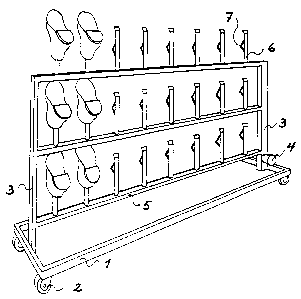Une partie des informations de ce site Web a été fournie par des sources externes. Le gouvernement du Canada n'assume aucune responsabilité concernant la précision, l'actualité ou la fiabilité des informations fournies par les sources externes. Les utilisateurs qui désirent employer cette information devraient consulter directement la source des informations. Le contenu fourni par les sources externes n'est pas assujetti aux exigences sur les langues officielles, la protection des renseignements personnels et l'accessibilité.
L'apparition de différences dans le texte et l'image des Revendications et de l'Abrégé dépend du moment auquel le document est publié. Les textes des Revendications et de l'Abrégé sont affichés :
| (12) Demande de brevet: | (11) CA 2150002 |
|---|---|
| (54) Titre français: | SUPPORT UTILISE POUR LA FABRICATION DES CHAUSSURES |
| (54) Titre anglais: | STAND FOR TREATMENT OF FOOTWEAR |
| Statut: | Réputée abandonnée et au-delà du délai pour le rétablissement - en attente de la réponse à l’avis de communication rejetée |
| (51) Classification internationale des brevets (CIB): |
|
|---|---|
| (72) Inventeurs : |
|
| (73) Titulaires : |
|
| (71) Demandeurs : |
|
| (74) Agent: | SMART & BIGGAR LP |
| (74) Co-agent: | |
| (45) Délivré: | |
| (86) Date de dépôt PCT: | 1993-11-22 |
| (87) Mise à la disponibilité du public: | 1994-06-09 |
| Requête d'examen: | 2000-11-16 |
| Licence disponible: | S.O. |
| Cédé au domaine public: | S.O. |
| (25) Langue des documents déposés: | Anglais |
| Traité de coopération en matière de brevets (PCT): | Oui |
|---|---|
| (86) Numéro de la demande PCT: | PCT/NO1993/000175 |
| (87) Numéro de publication internationale PCT: | NO1993000175 |
| (85) Entrée nationale: | 1995-05-23 |
| (30) Données de priorité de la demande: | ||||||
|---|---|---|---|---|---|---|
|
A stand for suspension of footwear dur-
ing treatment, such as washing, disinfecting,
blacking, impregnating and drying, wherein the
stand has a piping system provided with jets
for the secure retention of the footwear as well
as internal washing and disinfecting thereof.
The footwear is placed down onto the nozzle
pipe (6) and is washed internally as detergent
and disinfectant, respectively, are supplied to
the stand's piping system and are sprayed out
through the holes in the nozzle pipes. The stand
is preferably used in a facility for treatment of
footwear where the function of the stand is both
to permit internal washing and disinfecting of
the footwear and to hold the footwear in place
during the external treatment.
Note : Les revendications sont présentées dans la langue officielle dans laquelle elles ont été soumises.
Note : Les descriptions sont présentées dans la langue officielle dans laquelle elles ont été soumises.

2024-08-01 : Dans le cadre de la transition vers les Brevets de nouvelle génération (BNG), la base de données sur les brevets canadiens (BDBC) contient désormais un Historique d'événement plus détaillé, qui reproduit le Journal des événements de notre nouvelle solution interne.
Veuillez noter que les événements débutant par « Inactive : » se réfèrent à des événements qui ne sont plus utilisés dans notre nouvelle solution interne.
Pour une meilleure compréhension de l'état de la demande ou brevet qui figure sur cette page, la rubrique Mise en garde , et les descriptions de Brevet , Historique d'événement , Taxes périodiques et Historique des paiements devraient être consultées.
| Description | Date |
|---|---|
| Demande non rétablie avant l'échéance | 2005-04-11 |
| Inactive : Morte - Aucune rép. dem. par.30(2) Règles | 2005-04-11 |
| Réputée abandonnée - omission de répondre à un avis sur les taxes pour le maintien en état | 2004-11-22 |
| Inactive : Abandon. - Aucune rép dem par.30(2) Règles | 2004-04-13 |
| Inactive : Dem. de l'examinateur par.30(2) Règles | 2003-10-10 |
| Inactive : CIB en 1re position | 2003-02-13 |
| Lettre envoyée | 2000-12-19 |
| Inactive : Renseign. sur l'état - Complets dès date d'ent. journ. | 2000-12-18 |
| Inactive : Dem. traitée sur TS dès date d'ent. journal | 2000-12-18 |
| Exigences pour une requête d'examen - jugée conforme | 2000-11-16 |
| Toutes les exigences pour l'examen - jugée conforme | 2000-11-16 |
| Demande publiée (accessible au public) | 1994-06-09 |
| Date d'abandonnement | Raison | Date de rétablissement |
|---|---|---|
| 2004-11-22 |
Le dernier paiement a été reçu le 2003-10-29
Avis : Si le paiement en totalité n'a pas été reçu au plus tard à la date indiquée, une taxe supplémentaire peut être imposée, soit une des taxes suivantes :
Les taxes sur les brevets sont ajustées au 1er janvier de chaque année. Les montants ci-dessus sont les montants actuels s'ils sont reçus au plus tard le 31 décembre de l'année en cours.
Veuillez vous référer à la page web des
taxes sur les brevets
de l'OPIC pour voir tous les montants actuels des taxes.
| Type de taxes | Anniversaire | Échéance | Date payée |
|---|---|---|---|
| TM (demande, 4e anniv.) - petite | 04 | 1997-11-24 | 1997-11-05 |
| TM (demande, 5e anniv.) - petite | 05 | 1998-11-23 | 1998-11-12 |
| TM (demande, 6e anniv.) - petite | 06 | 1999-11-22 | 1999-10-22 |
| TM (demande, 7e anniv.) - petite | 07 | 2000-11-22 | 2000-10-25 |
| Requête d'examen - petite | 2000-11-16 | ||
| TM (demande, 8e anniv.) - petite | 08 | 2001-11-22 | 2001-10-24 |
| TM (demande, 9e anniv.) - petite | 09 | 2002-11-22 | 2002-10-28 |
| TM (demande, 10e anniv.) - petite | 10 | 2003-11-24 | 2003-10-29 |
Les titulaires actuels et antérieures au dossier sont affichés en ordre alphabétique.
| Titulaires actuels au dossier |
|---|
| TROSTERUD MEK. VERKSTED A/S |
| Titulaires antérieures au dossier |
|---|
| GISLE ESPOLIN JOHNSON |